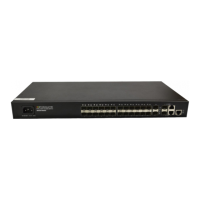Link Aggregation Configuration
Table 7-1 Configure a manual aggregation group
Create a static
aggregation group
channel-group channel-group-number
channel-group-number ranges
from 0 to 12
If the group has already
existed, turn to step 2.
Configure
load-balancing
policy
channel-group load-balance
{dst-ip|dst-mac|src-dst-ip|src-dst-mac|sr
c-ip|src-mac}
Enter interface
configuration mode
interface ethernet interface_num
Enter the port mode which you
want to add to the aggregation
group.
Enter interface
range configuration
mode
interface range ethernet interface_list
If there are multiple ports to be
added, enter interface range
mode.
Add a port to the
aggregation group
channel-group channel-group-number
mode on
channel-group-number should
be existed .
Delete a port from
an aggregation
group
no channel-group
channel-group-number
This command used in global
configuration mode is for
deleting a static aggregation
group.
Back to global
configuration mode
Delete a static
aggregation group
no channel-group
channel-group-number
This command used in
interface configuration mode is
for deleting a port from an
aggregation group.
Delete all ports from the group
first before deleting the group.
7.5 Configuring a Dynamic LACP
Aggregation Group
You can manually add/remove a port to/from a dynamic aggregation group, and a port can
only be manually added/removed to/from a dynamic aggregation group.
Perform the configuration in global configuration mode.
Table 7-2 Configure a dynamic LACP aggregation groups
Create a
dynamic
aggregation
group
channel-group
channel-group-number
channel-group-number ranges from 0 to
12
If the group has already existed, turn to
step 2.
channel-group load-balance
{dst-ip|dst-mac|src-dst-ip|src-
The default policy is source mac.

